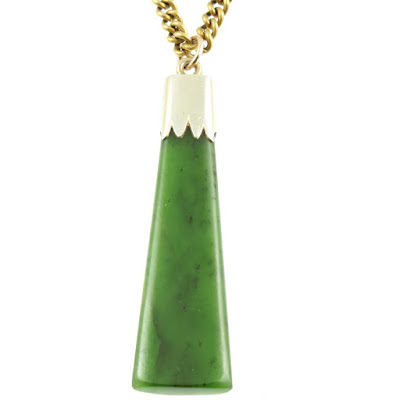#AD
It can be hard to know where to start if you are planning a major purchase of jewellery, perhaps for a special occasion. A gift for a special birthday or anniversary is something that should be treasured for many years to come, so you want to know that your chosen piece is what it says it is and that it's going to stand the test of time. Carus Jewellery offers one-of-a-kind pieces that each have their own history. Their website has articles on different eras of jewellery, drawing on their 25 years of experience in the industry. It's a great place to start if you have no idea what you are looking for. I am a big fan of vintage clothes and jewellery and I found out a lot about the evolution of jewellery through the ages. My favourite era for jewellery is probably the 1920s when Art Deco was popular. This was a prosperous time and everything was extravagant and opulent, like my favourite piece from their collection, this Art Deco Jade Pendant.
Buying second-hand items has really become popular in recent times and it's good to see the practice lose the stigma of being somehow second-best. With the huge popularity of shops with lower quality, cheaper items soaring, it has become harder to get value for money when you want to buy an item that lasts and sometimes buying secondhand can circumvent this issue. Jewellery is a great example of this since quality pieces last for generations and you can end up getting a real bargain if you know where to look. Auctions, flea markets and car boot sales are a great source of rummaging opportunity if you have the time and know what to look for. You might even get really lucky and find something valuable in your search. Here's how to spot a quality piece of jewellery:
Weight
Solid gold and silver are heavier than their fake counterparts, so as soon as you pick up a piece of jewellery, you will have some idea if it might be a quality piece. The same goes for precious stones. Diamonds are a lot heavier than their cubic zirconia counterparts and this is a good rule of thumb if you are unsure what you are looking at. If someone tells you it's a diamond and it's very light, it's probably cubic zirconia or even glass.
Magnets
Another way to tell if a piece of jewellery is made from precious metal or a lower quality alternative is to try it next to a magnet. Neither silver nor gold is magnetic, so if an item sticks to a magnet, you know straight away that it can't be either and is probably a base metal, coated in something shiny, possibly gold or silver plate, or an alloy.
Hallmarks
The stamped marks on any gold or silver piece of jewellery are the most reliable way to tell the provenance, and therefore the value, of the item. They can be a little tricky to read and you may need a magnifying glass, but you can find out where the item was assayed (checked and stamped), what year it was created and the quality of the silver or gold. The assay office has lots of information on hallmarks, including what year is represented by different date stamps on jewellery.
Appearance
Don't be put off if a piece of jewellery looks tarnished or dirty. Solid silver can become unsightly quite quickly if it is left in a box with other metals, or kept in a very humid environment, but a quick dip in some silver polish or even a rub with some toothpaste will return its natural shine and make it like new again.
I've had a lot of fun over the years rummaging for pieces of jewellery at car boot sales and flea markets, it's a real buzz when you find something that turns out to have a really interesting history. The important part is to always choose pieces you genuinely love, then it's not a huge disappointment if they don't turn out to be especially interesting. As well as doing your bit for the environment, antique jewellery gives you a great opportunity to own something truly unique and classically beautiful, that can be handed down to future generations so that you become part of its history. I love thinking about who owned the jewellery before and where it has travelled during its lifetime. Unlike clothes, classic jewellery stands the test of time and doesn't go out of fashion, so I know I can always wear vintage pieces whatever the occasion and they can be a real talking point too.




Those flower earrings are so pretty!
ReplyDelete